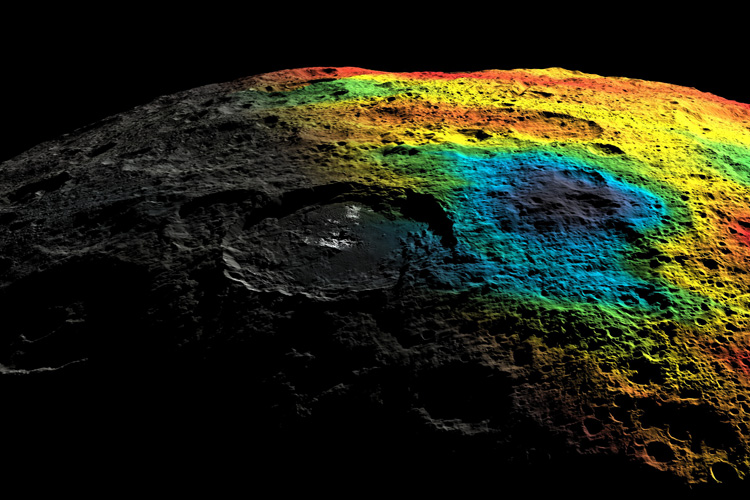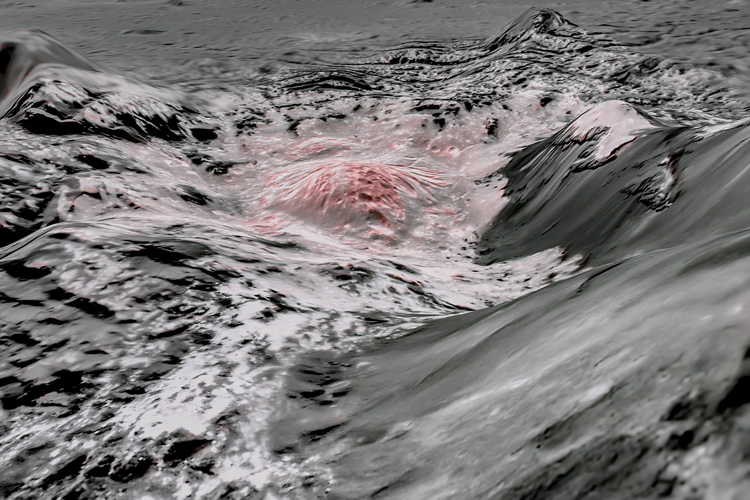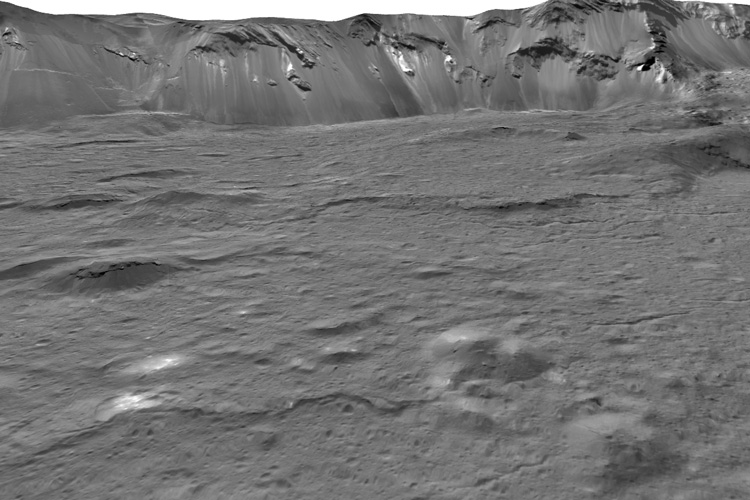Dwarf planet Ceres has reservoirs of salty water

The dwarf planet Ceres, the largest object in our Solar System’s main asteroid belt, once harbored a global subsurface ocean that likely froze solid long ago. Today, if any liquid water — a key requisite for habitability — still exists on Ceres, a good place to look for it is beneath the youngest of its large impact craters.
An analysis of low-altitude data from flyovers of Ceres’ 92-kilometer (57-mile) Occator crater by NASA’s Dawn spacecraft in 2018 has allowed researchers to characterize the underground structure near the crater and conclude from gravity data that there is a low density region beneath Occator consistent with a briny slush reservoir of water and various salts.
The data suggest that the impact that created the Occator crater 20 million years ago likely fractured Ceres’ crust, and those fractures today tap into deeper brine reservoirs. This hypothesis explains the formation of bright regions, or faculae, on the crater floor: brine erupted through these fractures, and a highly reflective salt crust was left behind as the water evaporated.
These bright regions were previously found to consist of sodium carbonates. The regions in Occator came into focus when Dawn first reached Ceres in 2015, and were photographed in sharp detail during the final extended mission. These deposits appear to have erupted within the last 2 million years, far too recent to have come from the melt generated by the initial impact.
The brines may still be percolating up to the surface today.

“In order for the bright deposits to form later, relative to the impact event, you need to be able to transport the briny material to the surface somehow over an extended period of time,” said geophysicist Anton Ermakov, a University of California, Berkeley, postdoctoral fellow who works with the Dawn team. “The potential mechanism would be that the impact-induced fracturing provided the connection between the surface and deeper brine reservoirs.”
The analysis, conducted by a team of scientists led by Carol Raymond of the Jet Propulsion Laboratory (JPL) at the California Institute of Technology in Pasadena, indicates that Ceres could have liquid water in its interior at present. While ice on the icy moons in the outer Solar System — Saturn’s Enceladus and Jupiter’s Europa, for example — is warmed and melted by gravitational tidal interactions with the planets, it now seems likely that dwarf planets and asteroids may also preserve reservoirs of liquid water, despite the fact that they do not benefit from the same tidal heating.
And as NASA often states, to find life on other planets, follow the water.
The findings are presented in a special collection of papers published today (Aug. 10) in the journals Nature Astronomy, Nature Geoscience and Nature Communications.
Probing cerean subsurface with gravity
Ceres was the first object discovered in the main asteroid belt, a vast region containing planet building blocks encircling the Sun — leftovers from the formation of the Solar System — between the orbits of Mars and Jupiter. Now referred to as a dwarf planet, like Pluto, Ceres is named after the Roman goddess of agriculture.

NASA launched the Dawn mission of the asteroid belt in 2007 to study Vesta, the second most massive object in the belt, and Ceres. After a successful survey of both objects, the spacecraft used up all its fuel in October 2018. It remains parked in a long-term orbit around Ceres.
Dawn’s final task in 2017 and 2018 was to get as close to Ceres as possible — about 35 kilometers, or 22 miles, above the surface at the closest approach. There, it could capture high-resolution pictures of the surface and map the gravity field, which tells scientists about the density variations of the subsurface layers of the planet.
One major question the team hoped to solve was the nature and origin of the bright regions, which had been noticed, long before Dawn arrived at Ceres, by scientists peering through telescopes. During 106 close approaches, Dawn captured images of two distinct, highly reflective areas within Occator that were officially named Cerealia Facula and the Vinalia Faculae.
The spacecraft also measured the gravity close to the surface, data that Ermakov and the Dawn team analyzed. They discovered a low-gravity region just outside Occator that indicated an underground blob of low-density material about 40 kilometers, or 25 miles, below the surface and hundreds of kilometers in extent. However, since the gravity data could not tell researchers what the actual composition of the underground anomalous blob was, they had to cross-analyze the gravity data against other available observations, such as local geology and composition inferred from spectroscopy. Such combined analysis led to the most likely scenario that the low-density region could be a reservoir of briny water.
The team proposed that initially, the impact melted ice underground in a small reservoir that mostly froze again within a few million years. However, the scientists recognized that the impact could have fractured rock deep enough to reach the reservoir inferred from the observed low gravity. Such fractures today would be conduits for brines moving upward and erupting on the surface.
“For the large deposit at Cerealia Facula, the bulk of the salts were supplied from a slushy area just beneath the surface that was melted by the heat of the impact that formed the crater about 20 million years ago,” said Raymond, principal investigator for the Dawn mission. “The impact heat subsided after a few million years. However, the impact also created large fractures that could reach the deep, long-lived reservoir, allowing brine to continue percolating to the surface.”
Ermakov emphasized that this interpretation is consistent with the gravity survey data and other measurements of the surface, but the data are insufficient to determine what that deep reservoir looks like or exactly how big it really is. However, it is possible to characterize the total mass deficiency created by the low-density reservoir.
“This paper provides the first coherent story for the connection between the surface evaporates and the deep brine for the region of Occator and leaves the question about whether the brine layer is global open to future investigation,” he said.
Ceres still geologically active
The research not only confirmed that the bright regions are young — some less than 2 million years old — but also found that the geologic activity driving these deposits could be ongoing. This conclusion depended on scientists making a key discovery: salt compounds — sodium chloride chemically bound with water and ammonium chloride — concentrated in Cerealia Facula.
On Ceres’ surface, salts bearing water quickly dehydrate. But Dawn’s measurements show they still have water, so the fluids must have reached the surface very recently. This is evidence both for the presence of liquid below the region of Occator and for the ongoing transfer of material from the deep interior to the surface.
Some of the evidence for recent liquids in Occator comes from the bright deposits, but other clues come from an assortment of unusual conical hills. These features are reminiscent of Earth’s pingos, small ice mountains in polar regions formed by frozen pressurized groundwater. Such features have been spotted on Mars, but the discovery of them on Ceres marks the first time they’ve ever been observed on a dwarf planet.
On a larger scale, Ermakov and his colleagues were able to map the density of Ceres’ crustal structure as a function of depth, a first for an ice-rich planetary body. Using the gravity measurements, they found Ceres has a complex crust that becomes denser as it gets deeper.
Researchers inferred that at the same time Ceres’ brine reservoir is freezing, salt and mud are incorporating in the lower part of the crust.
“Dawn accomplished far more than we hoped when it embarked on its extraordinary extraterrestrial expedition,” said Dawn mission director Marc Rayman of JPL. “These exciting new discoveries from the end of its long and productive mission are a wonderful tribute to this remarkable interplanetary explorer.”
